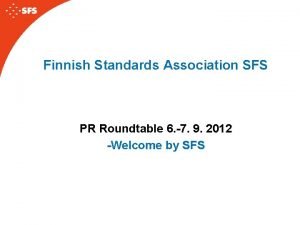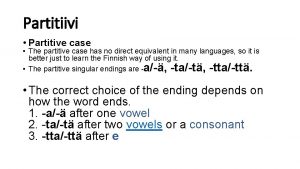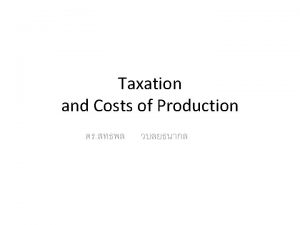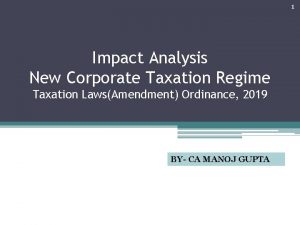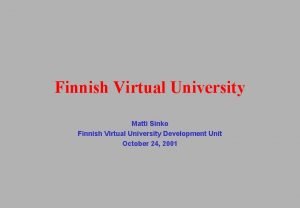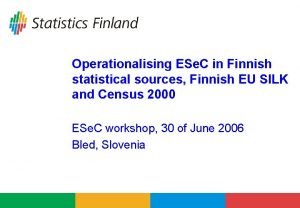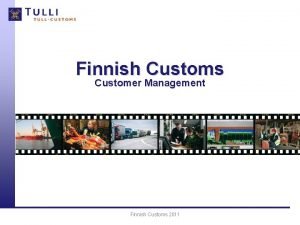General Features of Finnish Corporate Taxation Jouni Honkaaho









- Slides: 9


General Features of Finnish Corporate Taxation Jouni Honka-aho

GENERAL FEATURES OF FINNISH CORPORATE TAXATION • The usual form of doing business in Finland is a limited liability company (osakeyhtiö). Sometimes foreign enterprises start their activities in Finland with mere branches. – Both branches and limited liability companies are treated as separate tax subjects. • Also limited partnerships are used, especially for private equity fund activities. – Limited partnerships are flow-through entities, i. e. profits of limited partnerships are taxed in the hands of their partners. • Corporate profits are subject to national corporate income tax (CIT), which is currently 24. 5% calculated on the net profits.

TAXABLE INCOME, DEDUCTIBLE EXPENSES AND TAX LOSSES • Individuals and corporations with unlimited tax liability in Finland are liable to pay tax on all their worldwide profits. – Exceptions include, for example, the fairly broad participation exemptions applicable to dividends received and to capital gains from share sales. • Generally, expenses incurred in obtaining or preserving taxable income are deductible. Similarly, interest expenses are generally fully deductible. – However, aggressive intra-group leveraging may need to be scrutinized in order to prevent the application of anti-avoidance rules. • Losses derived from business activities may be carried forward to used to offset business income for the following 10 tax years. • Direct or indirect changes in ownership may under certain circumstances result in forfeiture of the carried-forward tax losses.

REPATRIATION OF PROFITS AND WITHHOLDING TAXATION Dividends and royalties • Withholding tax (WHT) applied at the rate of 24. 5%, unless they qualify for a domestic/EU exemption or a tax treaty provides for a lower rate. – For example, in accordance with the Finland-Russia tax treaty, a WHT of 12% is applicable to dividends. The WHT rate is 5% if the Russian dividend receiving entity holds at least 30% of the voting rights and has invested foreign capital in excess of $100 000 in the Finnish entity distributing dividend. • As regards royalties paid to Russia, no WHT is levied in Finland provided the amount of royalty is at arm’s length. Interests • Interests paid by Finnish companies to abroad are normally not subject to Finnish WHT.

CONSOLIDATION AND TAX COMPLIANCE • No consolidation regime exists. Profits may be balanced between affiliated Finnish companies (or Finnish permanent establishment) through group contributions under certain conditions (including, e. g. the ownership requirement of at least 90%). • The group contributions between affiliated companies are deducted from the taxable profits of the contributing company and added to the taxable income of the recipient company. • Tax returns of corporate taxpayers are due within 4 months of the closing of the financial year. The final assessment is issued by 31 October of the year following the tax year. – Usually monthly tax prepayments based on the income estimation are credited against final taxes and any deficit will be imposed any surplus refunded with interest. • Taxpayers may apply for advance rulings from tax offices or the Central Tax Board in most common tax-related questions.

TAX INCENTIVES AND ANTI-AVOIDANCE Incentives • No major tax incentive schemes exist. – Temporary accelerated depreciations. – Tonnage tax system Anti-avoidance regulation • General anti-avoidance rule (substance over form). • Specific transfer pricing rules and documentation requirement. – In line with the OECD rules. • Currently no specific thin capitalization or interest barrier regulation. – Prevention of thin capitalization arrangements is based on the general anti-avoidance rule. • Controlled Foreign Corporation (CFC) legislation.

CONTACT INFORMATION Jouni Honka-aho Senior Associate Direct +358 9 6153 3267 Mobile +358 50 512 4749 Email jouni. honka-aho@borenius. com Attorneys at law Borenius Ltd Yrjönkatu 13 A, FI-00120 Helsinki, Finland Office +358 9 615 333 Fax +358 9 6153 3499 info@borenius. com - www. borenius. com




